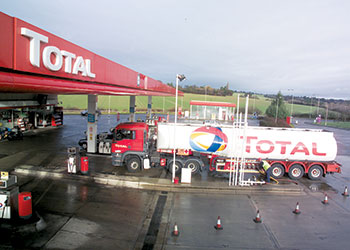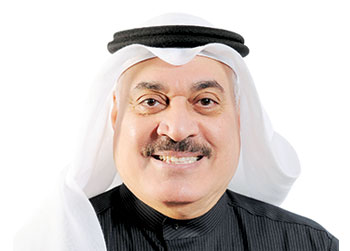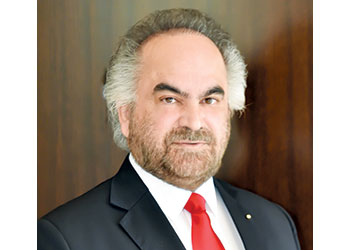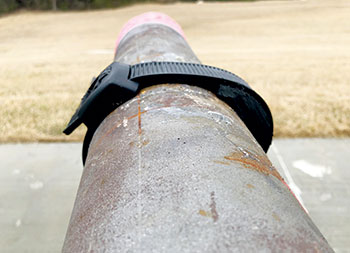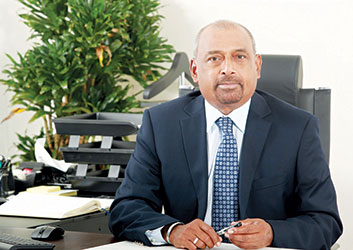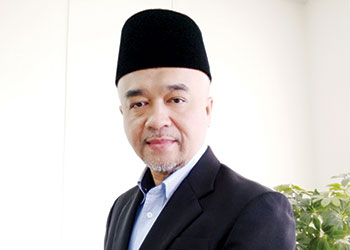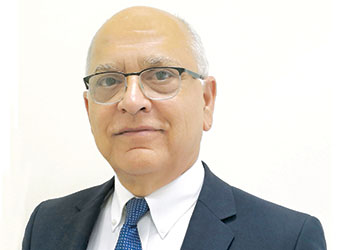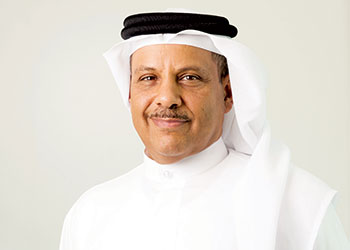
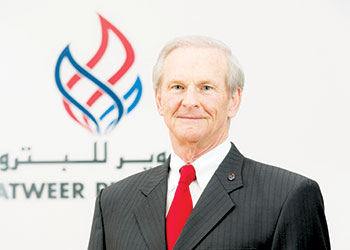 Eastlack ... taking on challenges
Eastlack ... taking on challenges
When Tatweer Petroleum assumed stewardship of the Bahrain Field, the kingdom’s oil production was at approximately 26,000 barrels per day (bpd). Crude and condensate production averaged 42,100 bpd in 2018
Tatweer Petroleum, a pathfinding venture created to increase the production of oil and maintain the availability of gas to meet the future energy demands of the Kingdom of Bahrain, has managed to increase production of oil from the Bahrain Field by over 60 per cent during the last ten years.
When Tatweer Petroleum assumed stewardship of the Bahrain Field, the kingdom’s oil production was at approximately 26,000 barrels per day (bpd). Crude and condensate production averaged 42,100 bpd in 2018. The black oil rate reached a high of 39,300 bopd in February 2018, and averaged 38,200 bopd for the year.
"This is mainly due to the dedication and efforts of our employees, using the knowledge and expertise of our previous partners, implementing new technologies, and focusing on generating innovative ideas. We hope to continue to maintain, if not increase, production despite the monumental challenges we face, which include the dip in global oil prices," said Jim Eastlack, CEO, Tatweer Petroleum in an exclusive interview with OGN.
The year 2018 was a remarkable year for the company following the public announcement of the discovery of Khaleej Al-Bahrain Basin (KAB) and Pre-Unayzah Gas, he says.
 |
Drilling more to boost ouput |
Tatweer Petroleum drilled three new Khuff gas wells in 2018 and drilling work is currently under way at Umm Al-Nasan Island with expected production results by the end of 2019, says Eastlack.
During 2018, Tatweer Petroleum continued further technical assessment and development in each reservoir. In the Ostracod/Magwa reservoirs, 37 wells were completed with high pressure high rate acid fracturing, adding 600 bopd incremental oil gain.
The Rubble Thermal Pilot Phase-6 project was expanded with the commissioning of ten wells, injecting its first steam. Crestal gas injection continued in the Ahmadi reservoir, adding an incremental 100 bopd, flattening the reserve decline.
The commissioning of Zero Operating Pressure skids (ZeroP) at Tank Batteries 01 and 02 achieved a total gain of 700 bopd. In relation to gas operations, the new 500 million standard cubic feet per day (mmscfd) CGDU was finally commissioned, he reveals.
Eastlack says Tatweer Petroleum continues to invest in Bahrain’s local workforce and is dedicated to the development of Bahraini nationals through training and knowledge transfer. The company takes pride in the rise of its nationalisation rate to over 83 per cent in 2018.
The company also continues to focus on the health, safety, and environment aspects of its operations. In 2018, Tatweer Petroleum exceeded expectations set for the safety observation cards programme, by reporting an average of thirteen reports per employee, which surpassed its goal of eight reports per employee.
Excerpts from the interview:
 |
Tatweer ... boosting production |
It was reported that Bahrain plans to increase its gas production by drilling new wells in the Bahrain Field, in order to double the volume of associated gas. How many more wells are planned? What is the total number of wells drilled till end-2018?
Tatweer Petroleum drilled three new Khuff gas wells and 69 new oil wells in 2018, targeting the Rubble, Ahmadi, Mauddud and Kharaib reservoirs. The total number of new wells drilled since Tatweer’s inception in 2009 is 1,021, including 7 Khuff gas wells. The current programme for Khuff gas wells includes drilling three additional wells by 2020.
What is the deliverability and production of Non-Associated Gas (NAG) from the Bahrain Field?
Total Khuff gas production averaged 1,430 mmscfd, with a peak production rate of 1,860 mmscfd in June 2018.
Could you comment on the safety performance of Tatweer during 2018?
The 2018 combined Total Recordable Injury Rate (TRIR) for Tatweer Petroleum showed an improvement over last year’s rate. The company’s Health, Safety, and Environment department is continuously working to minimise this rate and maximum efforts are continued to be exerted towards safety awareness.
After about 10 years of operation how much have you been able to improve production at the Bahrain Field?
When Tatweer Petroleum assumed stewardship of the Bahrain Field, the kingdom’s oil production was at approximately 26,000 barrels per day (bpd). Since then, Tatweer has managed to increase production by over 60 per cent of that rate. This is mainly due to the dedication and efforts of our employees, using the knowledge and expertise of our previous partners, implementing new technologies, and focusing on generating innovative ideas. We hope to continue to maintain, if not increase, production despite the monumental challenges we face, which include the dip in global oil prices.
A technician at the controls
Have you achieved your output targets? If not, why? If yes, what were the factors that contributed towards the achievement?
.jpg)
Tatweer Petroleum has maintained a steady production rate through the drilling of an additional 69 new wells, targeting the Ahmadi, Mauddud, and Kharaib reservoirs. Total oil and condensate production averaged 42,100 bpd, declining from 2017 production average of 44,200 bpd by 2,100 bpd. This decline in production was mainly due to the decline of drilling new wells in 2017, as well as the planned and unplanned facility shutdowns. The production capacity of Non-Associated Gas (NAG) was successfully maintained at 1.4 billion cubic feet per day, meeting the Kingdom of Bahrain’s average and peak demands for energy.
Tatweer Petroleum’s multidisciplinary team, which was formed in 2016, continues to combine the efforts of Operations, Facilities, Subsurface, Production Engineering and Maintenance, Supply Chain and Executive Management in order to improve oil production. The team has carried out significant surface and subsurface improvements, including operations enhancement, identifying physical bottlenecks, review of underperforming wells, exploring new ways to identify and tackle wells issues, and continuously strive in accelerating other project works.
Do you plan fresh capital injection to fast-track the field development?
Tatweer Petroleum continues to invest in its pilot appraisals for thermal enhanced oil recovery in readiness for when oil prices recover. Our spending this year will be highly optimised in order to focus on the best opportunities to maximise the economic production of oil. Since the start of the oil price downturn, we have successfully managed our programmes to reduce our costs of production and we are now among the lowest of the regional producers, to an extent that eases some of the pressure we face under this low oil price environment. Choosing the best development wells as well as dramatically scrutinising and improving the margin on each dollar we invest is essential.
Extensive promotion for KAB, Pre-Unayzah Gas, and Offshore Exploration Blocks were conducted in 2018 and International Oil Companies (IOCs) were welcomed from the United States, Europe and Asia to access Tatweer Petroleum data rooms. In addition, a promotional project was launched to attract foreign interest, particularly for the two discoveries of oil in KAB and gas in Pre-Unayzah.
What are the targets set by Tatweer for 2019?
Tatweer Petroleum plans to continue its focus on optimising the ongoing Improved Oil Recovery schemes such as steam injection and artificial lifting techniques which have shown good potential to extract more difficult oil from the Bahrain Field.
Additionally, with the discovery of the KAB, which is the biggest discovery since 1932 with over 80 billion barrels of tight oil in place, we are now working on drilling and development operations in this large scale offshore shale formation. Our target is to see production results by the end of 2019.
What was the black oil production exit rate at the end-2018? What was the average oil production rate average in 2018?
Crude and condensate production averaged at 42,100 bpd in 2018. The black oil rate reached a high of 39,300 bopd in February 2018, and averaged 38,200 bopd for the year.
What are the challenges that you face currently in your task of boosting output? How do you overcome them?
The most significant challenge we are facing continues to be the low oil price. In addition, we have a very complex set of 16 stacked reservoirs from extra-heavy oil near the surface to very light oil deeper down in the structure. Each reservoir has its own unique characteristics and requires different recovery techniques to be applied – they also require an enormous amount of hard engineering work to keep them performing. But having said that, Tatweer Petroleum has one of the strongest technical teams in the industry who is ready and prepared for any challenges.
What were the new construction projects undertaken during 2018?
In 2018 Tatweer Petroleum commenced a number of projects with the aim to streamline operations and increase production. The new 500 mmscfd Central Gas Dehydration Unit (CGDU), which is part of the NAG Long Term Field Development (LTFD) Project, was commissioned in 2018.
Construction was completed on all three Khuff gas wells in 2018 and the engineering and procurement process was started for three additional Khuff wells.
An additional 50 beam pump wells were connected to the 11 KV network, bringing the total number of phased-out Beam Pump rental diesel generators (converted to permanent power) to 579 in 2018.
A control system upgrade was completed at the remaining three remote oil well manifolds in 2018. The project has achieved better surveillance and control from the Central Control Facility through fiber optic connectivity, thereby bringing the entire oil, water and steam production into the high speed fiber optic network.
What new technologies have you employed in 2018 to improve production at the Bahrain Field?
Tatweer Petroleum continued further technical assessment and development in each reservoir. In the Ostracod/Magwa reservoirs, 37 wells were completed with high pressure high rate acid fracturing, adding 600 bopd incremental oil gain. The Rubble Thermal Pilot Phase-6 project was expanded with the commissioning of 10 wells, injecting its first steam. Crestal gas injection continued in the Ahmadi reservoir, adding an incremental 100 bopd, flattening the reserve decline. The commissioning of Zero Operating Pressure skids (ZeroP) at Tank Batteries 01 and 02 achieved a total gain of 700 bopd. In relation to gas operations, the new 500 mmscfd CGDU was finally commissioned.
What are the green initiatives being undertaken by Tatweer?
Tatweer Petroleum initiated a number of new environmental projects in 2018, including the Wetlands for Produced Water Treatment project, which is a natural water treatment system that removes contaminants via a range of natural processes. The process is mediated by complex interactions between water, plants, microorganisms, soil/gravel media, and the atmosphere. This project will help improve the Kingdom of Bahrain’s water sector’s resilience to climate change by using new innovative technologies to treat waste water, reduce extraction of groundwater, and supplement aquifer recharge. Wetland technology provides a natural, green, and sustainable solution for the oil and gas sector.
Kindly elaborate on Tatweer’s innovative use of the Geographical Information System, for which you won an award?
The GIS team at Tatweer Petroleum developed its recent real-time GIS application, which was designed to highlight operational awareness of critical operational events using real-time streaming of data imposed on the spatial map under the title of SCOPE (Surveillance and Control of Operation Production Environment). This application has been developed as a pilot project covering specific traits related to Tatweer Petroleum’s producing wells that are focused on seven traits such as alarms for events, including high flow line pressure, dead wells, shut-ins, transmitter
errors, etc.
Tatweer Petroleum received the 2018 Excellence in GIS Implementation (EGI) Award during the GISWORX Conference held in Dubai, UAE, under the title of "GIS in Critical Oil Operations". The award was given to Tatweer Petroleum for its advanced usage of the GIS technology such as geographical and spatial data gathering, management and analytics to aid its various daily operations and also as a part of Tatweer Petroleum’s drive to improve efficiency and effectiveness of its operation processes.
Could you update us about the AlHunayniya Plantation project?
AlHunainiya plantation project is an initiative undertaken by Tatweer Petroleum in 2018 and aims to utilise treated water from its field operation to landscape the AlHunainiya area in Bahrain. Phase 1 of the project, which is planned for completion by 2020, currently covers an area of 0.8 sq km and will be expanded further in the future. The project has shown promising results thus far and the total amount of treated water consumption for the full project is estimated at 30,000 cu m per day.
What does the MoU with Bahrain University entail?
Tatweer Petroleum signed a Memorandum of Understanding (MoU) with the University of Bahrain (UOB) in 2018. The MoU incorporates collaborative research and development opportunities in the field of Data Science and Artificial Intelligence in the oil and gas industry. Tatweer Petroleum and UOB will work together to investigate new ways to analyse, visualise and understand machine learning processes and data analytics algorithms, leveraging Tatweer Petroleum’s existing big data models and efficient collection of data through Internet of Things (IoT).



















































































